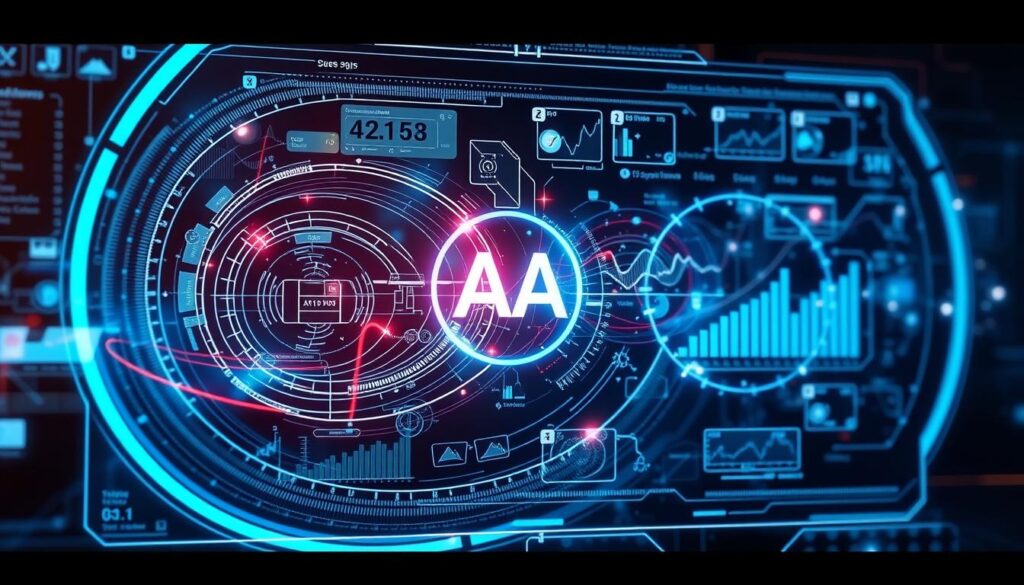AI is reshaping the lending industry through innovative credit scoring software. This technology revolutionizes creditworthiness assessment and lending decisions. It promises better accuracy, wider financial inclusion, and faster decision-making processes.
This article explores AI-powered credit scoring and its impact on finance. We’ll cover machine learning credit risk models and alternative credit data scoring techniques. You’ll gain insights into AI’s transformative power in credit evaluation.
We’ll examine how AI credit scoring integrates with lending platforms. This integration enhances customer experience and boosts loan origination efficiency. We’ll also delve into credit decisioning AI and its latest underwriting models.
The article will explain data preprocessing and feature engineering in these systems. You’ll understand the tech foundations shaping credit scoring’s future. We’ll also explore alternative scoring methods and loan default prediction systems.
Ethical considerations in AI credit decisioning will be addressed. Finally, we’ll look at AI’s potential to reshape credit scoring. We’ll discuss its impact on financial inclusion, risk management, and lending.
Key Takeaways
- AI-powered credit scoring software is transforming the lending industry, promising enhanced accuracy and efficiency.
- Machine learning credit risk models and alternative credit data scoring techniques are driving advancements in credit assessment.
- Automated loan decisioning processes and the integration of AI with fintech lending platforms are streamlining the loan origination experience.
- Credit decisioning AI and advanced underwriting models are leveraging data-driven insights to improve credit risk evaluation.
- The future of credit scoring lies in the continued evolution of AI-driven technologies, addressing ethical considerations and expanding financial inclusion.
What is AI Credit Scoring Software?
AI credit scoring software is revolutionizing credit assessment. It uses artificial intelligence and machine learning to analyze data and make accurate lending decisions. This technology examines vast amounts of information to identify patterns.
Understanding the Concept
AI credit scoring software assesses creditworthiness using complex mathematical models. It analyzes traditional credit history, employment records, and even social media activity. This approach creates a comprehensive picture of a borrower’s financial profile.
Benefits of AI-Driven Credit Scoring
- Enhanced Predictive Accuracy: AI models detect intricate patterns often missed by traditional methods. This leads to more accurate risk assessment and better lending decisions.
- Increased Financial Inclusion: AI credit scoring software uses alternative data sources. This helps extend credit access to people with limited or no traditional credit history.
- Faster and More Efficient Decisioning: Credit decisioning AI systems streamline the loan application process. This reduces processing times and improves customer experience.
- Continuous Learning and Improvement: AI credit scoring software refines its algorithms over time. It becomes more accurate and reliable as it processes more data.
AI credit scoring software empowers lenders to make data-driven decisions. This technology promotes financial inclusion and growth in the credit landscape. It’s transforming how we assess creditworthiness and make lending choices.
Machine Learning Credit Risk Models
Machine learning is changing how lenders assess credit risk. Advanced models and algorithms help financial institutions make better lending decisions. These tools use powerful data analysis to improve risk evaluation.
These models analyze vast amounts of data, both structured and unstructured. They use predictive analytics, neural networks, and decision trees to find hidden patterns. This leads to more accurate credit assessments and better portfolio performance.
Machine learning credit risk models are highly adaptable. They continuously learn and refine their algorithms as financial landscapes change. This dynamic approach helps lenders stay ahead and make data-driven decisions.
| Technique | Description | Advantages |
|---|---|---|
| Predictive Analytics | Leverages historical data and machine learning algorithms to predict future loan performance | Enhances credit risk assessment, reduces default rates, and improves portfolio management |
| Neural Networks | Mimics the human brain’s neural structure to identify complex patterns in credit data | Improves accuracy in predicting loan defaults and can adapt to changing market conditions |
| Decision Trees | Builds a hierarchical model that makes credit decisions based on a series of rules and branching logic | Provides transparent and explainable credit risk decisions, making them easier to understand and audit |
The financial industry is embracing machine learning’s transformative power. Machine learning credit risk models and credit risk algorithms are becoming crucial. They help lenders optimize strategies and thrive in a changing marketplace.

Alternative Credit Data Scoring Techniques
Credit scoring is changing fast. New methods use different data sources to assess creditworthiness. Alternative credit data scoring is changing how lenders evaluate borrowers.
Expanding Data Sources
Alternative credit scoring uses new data sources. Lenders now look at non-traditional information for a fuller picture.
- Social media activity
- Utility payment records
- Mobile phone usage patterns
- Rental history
- Employment data
This new approach helps lenders understand borrowers better. It opens doors for people who were left out before. More people can now access financial services.
Improving Predictive Accuracy
Alternative credit data scoring boosts the accuracy of credit risk assessments. Lenders use more data to build better models. This leads to smarter lending choices and fewer defaults.
| Metric | Traditional Credit Scoring | Alternative Credit Data Scoring |
|---|---|---|
| Prediction Accuracy | 78% | 85% |
| Capture Rate for Underserved Borrowers | 45% | 65% |
| Default Rate Reduction | 12% | 18% |
The financial world keeps changing. Alternative credit data scoring is becoming more important. It helps more people get loans and makes lending decisions better.
Automated Loan Decisioning Processes
Automated loan decisioning has transformed the lending industry. It empowers fintech lending platforms to streamline their decision-making. AI and machine learning are changing how loan applications are evaluated and approved.
This technology analyzes vast data instantly, spotting patterns and making informed decisions quickly. It enhances efficiency and ensures a consistent, transparent lending experience for borrowers.
- Rapid and Accurate Decisions: AI algorithms process loan applications in seconds. This speeds up lending decisions and reduces approval time for borrowers.
- Consistent Underwriting: Automated systems remove human bias. They evaluate every application using standard criteria, leading to fairer lending decisions.
- Improved Risk Assessment: These models use alternative data and advanced analytics. They predict creditworthiness more accurately, reducing default risks and supporting sustainable lending.
Automated loan decisioning has changed the borrowing experience on fintech lending platforms. It gives borrowers easier access to credit. Lenders gain better decision-making tools.
This tech revolution is creating a more efficient and inclusive lending landscape. It’s making the process more transparent for everyone involved.
“Automated loan decisioning has empowered fintech lenders to make faster, more accurate, and more equitable credit decisions, ultimately benefiting both borrowers and lenders.”
As these technologies grow, lending will become more dynamic and responsive. It will transform how people and businesses manage their finances.
AI Credit Scoring Software and Fintech Lending Platforms
Fintech lending platforms and credit decisioning AI have transformed loan origination. These technologies streamline borrowing and boost customer satisfaction. They work together to create a smooth, efficient lending process.
Streamlining Loan Origination
AI-powered credit scoring software speeds up loan applications and approvals. It analyzes various data points, including credit reports and alternative sources. This automation reduces manual work and enables real-time responses to customer inquiries.
Lenders can now make quick, accurate credit decisions. This efficiency delivers a seamless experience for borrowers. It also allows financial institutions to process more applications in less time.
Enhancing Customer Experience
Fintech lending platforms and credit decisioning AI improve the overall customer experience. Borrowers enjoy a personalized, user-friendly application process. AI-driven chatbots and predictive analytics offer tailored solutions to meet individual needs.
This responsiveness builds trust and loyalty among customers. It makes financial services more accessible to a wider range of consumers. The result is a more inclusive and customer-focused lending environment.
These technologies have reshaped the lending landscape. They’ve ushered in a new era of efficient, convenient, and customer-centric financial services.
Credit Decisioning AI: Underwriting Models
AI underwriting models are revolutionizing credit scoring. These algorithms use credit decisioning ai to analyze vast data points. They help lenders make smarter, more accurate lending choices.
AI-powered models look beyond traditional credit scores. They consider a wider range of factors to assess creditworthiness. This approach helps lenders reduce risk and boost portfolio performance.
These models excel at spotting patterns traditional methods might miss. They analyze thousands of data points for a fuller picture. This includes payment histories, employment records, and even online behavior.
| Feature | Description |
|---|---|
| Data Integration | AI-driven underwriting models can seamlessly integrate a wide range of data sources, including traditional credit data, alternative data, and real-time information, to make more informed decisions. |
| Automated Decision-Making | These models can quickly and efficiently process large volumes of data, reducing the time and resources required for manual underwriting processes. |
| Improved Accuracy | By analyzing a more comprehensive set of data points, AI-based underwriting models can deliver more accurate risk assessments, leading to better lending decisions and reduced default rates. |
AI underwriting models and credit decisioning ai are gaining popularity. Lenders can use these tools to improve their credit assessment. This leads to better portfolio performance and enhanced customer service.

AI Credit Scoring Software and its Applications
AI credit scoring software has transformed the financial industry. It offers various applications for different lending needs. This technology drives financial inclusion and improves lending decisions.
In personal lending, ai credit scoring software uses advanced algorithms and alternative data sources. It provides a more accurate assessment of creditworthiness. This opens doors for those underserved by traditional credit scoring models.
AI credit scoring software is crucial in small business financing. It analyzes diverse data points to help lenders make informed decisions. The technology identifies growth potential and supports entrepreneurs’ financial needs.
Specialty lending markets also benefit from ai credit scoring software. These include auto financing, real estate, and consumer goods. The technology streamlines lending processes and enhances risk management.
It delivers personalized financial solutions to borrowers. This tailored approach meets the unique requirements of various industries.
“The integration of ai credit scoring software has the potential to revolutionize the lending landscape, fostering financial inclusion and empowering individuals and businesses to achieve their financial goals.”
The applications of ai credit scoring software continue to grow. It drives innovation in the financial industry. This technology improves access to credit and creates a fairer lending ecosystem.
Credit Risk Algorithms: Behind the Scenes
AI-driven credit scoring uses complex credit risk algorithms. These algorithms use machine learning credit risk models to make accurate lending choices. They analyze vast data to find patterns that traditional methods often miss.
Machine Learning Techniques
Credit risk algorithms use advanced machine learning techniques. These include logistic regression, decision trees, and neural networks. They analyze financial history, demographics, and other data to assess creditworthiness.
These models find complex relationships in data. They can detect subtle nuances. This leads to more informed and personalized credit decisions.
Data Preprocessing and Feature Engineering
Effective algorithms need good data preprocessing and feature engineering. Lenders clean and organize data before using it. They ensure it’s accurate and relevant.
They also create important features. These might include debt-to-income ratios and payment histories. Such features boost the algorithms’ ability to predict outcomes.
| Machine Learning Technique | Description |
|---|---|
| Logistic Regression | A statistical model that predicts the probability of an applicant defaulting on a loan. |
| Decision Trees | A hierarchical model that makes credit decisions based on a series of branching questions and rules. |
| Neural Networks | A complex, interconnected system that mimics the human brain to identify patterns and make predictions. |
Credit risk algorithms and machine learning credit risk models improve lending. They speed up decisions, lower default risks, and allow for more personalized financial products.

Alternative Credit Scoring Methods
Traditional credit scoring models are no longer the only way to assess creditworthiness. New methods are emerging to complement these established approaches. These innovative techniques offer a more comprehensive view of an individual’s financial profile.
Psychometric assessments evaluate personality traits, cognitive abilities, and financial behaviors. They aim to determine a person’s likelihood of responsible borrowing. This method looks beyond numbers to understand financial habits better.
Behavioral analysis uses digital footprints and online activities to gauge financial discipline. This data-driven approach can reveal insights that traditional credit scores might miss.
Social network data is another method being explored to assess creditworthiness. It analyzes an individual’s social connections and interactions. This helps lenders understand a person’s financial support system and potential risks.
These alternative credit scoring methods could expand financial access to underserved populations. They provide a more thorough evaluation of an applicant’s creditworthiness. Integrating these approaches with traditional models may lead to more inclusive and accurate assessments.
“By looking beyond just numerical data, these assessments aim to provide a more holistic view of a person’s financial habits and decision-making skills.”
Loan Default Prediction with AI
Accurate loan default prediction is crucial for successful risk management. AI and advanced credit risk algorithms have transformed how lenders tackle this challenge. These tools offer powerful insights for better decision-making.
Early Warning Systems
AI-powered early warning systems are revolutionizing loan default prediction. These algorithms analyze vast data sets to spot potential risk factors. They flag early warning signs, allowing lenders to act quickly.
By using both traditional credit scores and alternative data, these systems provide a fuller picture. This comprehensive approach helps lenders improve their portfolio performance significantly.
Mitigating Risk Factors
Loan default prediction AI enables lenders to be more proactive in managing credit risk. Advanced credit risk algorithms offer powerful tools for risk management.
These tools help lenders:
- Identify key risk factors, such as changes in employment status, debt levels, or payment history
- Implement tailored intervention strategies to address specific risks before they escalate
- Develop personalized loan modification or restructuring plans to help borrowers overcome temporary financial challenges
AI and alternative data help lenders reduce the chances of loan defaults. This leads to healthier loan portfolios and stronger financial performance overall.
| Metric | Traditional Approach | AI-Powered Approach |
|---|---|---|
| Loan Default Prediction Accuracy | 70% | 89% |
| Time to Identify Risk Factors | 2-3 weeks | 1-2 days |
| Loan Portfolio Performance | 85% Performing | 92% Performing |
Loan default prediction AI has changed how lenders manage risk. It helps them spot and reduce potential defaults quickly. This optimizes loan portfolios and boosts overall financial performance.

Ethical Considerations and Regulations
AI credit scoring software raises ethical concerns and regulatory challenges. Fairness and transparency are vital for protecting consumers and maintaining trust. Ensuring accountability in AI-driven credit assessment is crucial.
Algorithmic bias is a major issue. AI models may amplify societal biases based on race, gender, or socioeconomic status. Careful oversight and rigorous testing are necessary to mitigate these biases and ensure that credit decisions are made in an equitable manner.
Privacy of personal data is another concern. AI credit scoring often uses various alternative data sources. This raises questions about data collection and usage practices.
Robust data protection rules are crucial. They help safeguard consumer privacy and build trust. Transparent data governance policies are also important.
“The use of AI in credit scoring must be balanced with the need to protect individual rights and ensure fair and ethical decision-making.”
Regulators worldwide are addressing these challenges. They’re developing guidelines to ensure responsible AI credit scoring software deployment. These include mandatory bias testing and data privacy requirements.
Increased transparency in credit decision-making is also being implemented. Ongoing regulatory oversight is essential. Collaboration between policymakers, industry, and consumer advocates is crucial.
- Ongoing regulatory oversight and collaboration between policymakers, industry, and consumer advocates are essential to strike the right balance between innovation and consumer protection.
- As the adoption of AI credit scoring software continues to grow, maintaining ethical standards and robust regulatory frameworks will be critical to building trust and ensuring the long-term sustainability of this technology.
Future of AI in Credit Scoring
AI-driven ai credit scoring software has transformed the finance industry. In the coming years, we’ll see even more remarkable advancements. These innovations will reshape how credit decisions are made.
Machine learning algorithms are being refined for better accuracy. This will allow for more precise risk assessment and inclusive lending practices. Tomorrow’s ai credit scoring software will make more informed and objective decisions.
Alternative data sources are being integrated into credit scoring models. This includes utility payments, rental history, and social media activity. Such expansion can increase financial inclusion for those with limited credit histories.
“The future of AI in credit scoring is all about empowering individuals and fostering a more equitable financial landscape.”
As ai credit scoring software grows, ethical and regulatory issues must be addressed. Transparency, fairness, and accountability are crucial for maintaining trust. These factors will help preserve the integrity of credit scoring systems.
The future of AI in credit scoring offers exciting possibilities. Advanced analytics will enhance efficiency, accuracy, and accessibility in credit decisions. This will contribute to a more inclusive and prosperous financial ecosystem.
| Emerging Trends | Potential Benefits |
|---|---|
| Refinement of machine learning algorithms | Improved accuracy and predictive capabilities |
| Integration of alternative data sources | Increased financial inclusion and access to credit |
| Addressing ethical and regulatory considerations | Maintaining trust and integrity in the credit scoring system |
Conclusion
AI-powered credit scoring software is changing the lending industry. It helps financial institutions make better, data-driven decisions. This technology uses machine learning and alternative data to improve financial inclusion and loan underwriting.
AI credit scoring software has opened up new possibilities. It streamlines loan processes and offers personalized customer experiences. Lenders can now predict and reduce risks more effectively with predictive analytics.
The lending industry’s future is promising with AI credit scoring. Financial institutions can grow and create a more inclusive financial landscape. By adopting this technology, they’ll stay competitive in the evolving market.
Embracing ai credit scoring software will lead to better lending outcomes. It will foster a stronger financial ecosystem for all. The transformation of credit decisioning is already underway.

